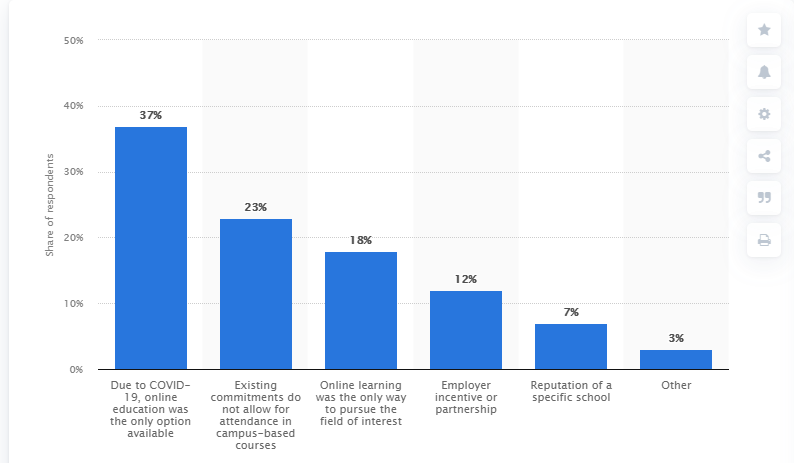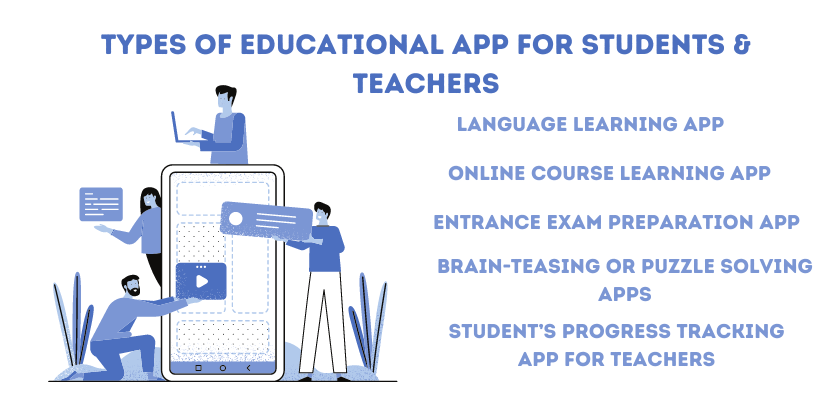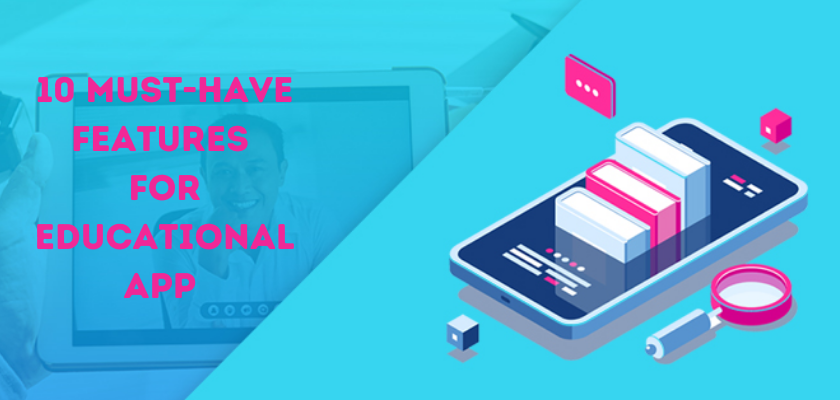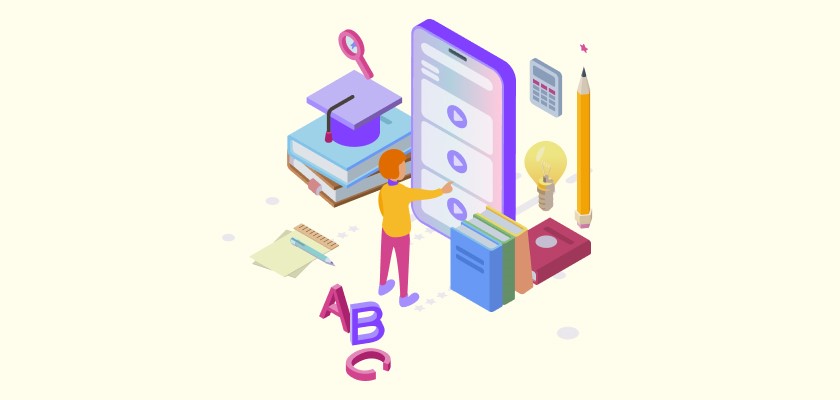Mobile app development is a big investment for any business- whether it’s an educational industry, healthcare industry, or retail industry. It not only helps businesses to cultivate customer’s trust, loyalty but also enhances the accessibility towards the brand.
So, if you are lining up an e-learning app project in 2021, then you need to understand many things such as:
- What features do you need to put into your educational app?
- What factors influence the cost of mobile app development for education?
- How much do you need to invest in developing an education app?
Therefore, if you are interested in getting the answers to all the above questions in one place, stay connected to this blog until the end. Today, we will learn everything important for you to understand before starting your educational app project.
Let’s start with stats for Online Education App.
Highlights of Contents
The Statistics of E-Learning & Education Mobile Application 2021
- As per Statista report, 43% of US students feel e-learning technologies help work on their homework.
- As of 2021, 37% of US students who go for the online degree programs said the COVID-19 outbreak had left the only option in front of them.

Image Source: https://www.statista.com/statistics/731089/reasons-why-students-chose-online-versus-on-campus-degree-programs/
These stats show how mobile education apps are becoming more and more popular, so you must take the time to find out how you can leverage its advantage. To ease down your research work, here are some benefits of having an e-learning app.
Benefits of Having an Educational App
Educational applications offer many benefits, such as improved efficiency and accessibility. Not only that, such apps are an excellent way for schools and universities to teach their students where they are giving most of their time: on their phones! They also provide a way for students to work on their own time due to increased mobility. Like this, there are some more advantages of having an educational app:
- Mobile apps have the potential to help teachers and students collaborate more effectively.
- It enables instructors to provide interactive content that engagingly supplements their lesson plans.
- Mobile learning apps can be a helpful tool for parents who want to stay connected with what’s happening at school, especially if they cannot attend parent meetings or have regular look-ups for their children.
- Mobile apps increase engagement with students and parents, as well as teachers.
- It can be used in schools by reducing classroom management time spent on paperwork, printing materials, or making copies.
Now, let’s have a glimpse at different categories of educational apps in the market.
Start Your Educational App Development Journey After Knowing Its Different Categories, developmental cost, factors influencing cost, etc.
Types of Educational App For Students & Teachers

Educational apps for students can do wonders, from providing homework help to working on their projects all alone at home. Similarly, mobile apps can also help teachers keep their students engaged in the classroom by providing interactive content that supplements lesson plans. Therefore, let’s understand different categories of Educational apps.
1. Language Learning App
Language learning apps are educational tools that utilize mobile devices to teach a language. They work by allowing users to view vocabulary, practice conversations, learn phrases, and more through various games on the phone.
Besides, Language Learning Apps allow you to take your lessons anywhere and become perfect for self-directed learners. Above all, it’s high in demand and offers an excellent opportunity for implementing a monetizing strategy that can add big money to your wallet.
2. Online Course Learning App
Online course learning apps are designed to help you learn students by themselves or with their classmates. It can be used for lessons in person or remotely. These online course apps include different tools that make it easier for students to engage with the materials.
3. Entrance Exam Preparation App
Entrance exam preparation Mobile apps are intended to help students get ready for an entrance test. They work by providing them with questions of different types on their actual test to practice and prepare for it.
4. Brain-Teasing Or Puzzle Solving Apps
Brain-teasing Mobile apps are puzzles and games that have been created to stimulate your brain. Mobile devices can be used for lessons in person or remotely, and mobile games offer a low-cost alternative to other methods of entertainment.
5. Student’s Progress Tracking App For Teachers
Student’s progress mobile apps are designed to help teachers track the student’s performance. Such tracking apps provide a low-cost alternative to other methods of monitoring student progress that may be too expensive or inconvenient.
Till now, you know m-learning applications benefits, its five different categories, and market update. So, now, let’s step ahead and figure out educational, mobile app development cost factors and features.
Check Out: Top 20 Mobile App Development Companies in India – Choose the Best in 2021
What Features Does An Educational App Make User’s Favorite?

Every educational app has a different goal. Some educational apps are intended to support the educational process directly, while others for indirect support. Therefore, choosing your educational app features wisely is important, following your product’s educational goals.
Here are some basic features that you may consider when developing your educational app:
1. The Log-in or Registration
Most Mobile app developers will require a user to register before they can use the mobile apps. You may have heard of this process as “logging in” or ‘’creating an account’’, both options allow you to go inside and use the other features available in the app.
2. Educational content
One of the features of educational apps is educational content. As an educational app aims to support the educational process and learning, it must provide quality educational content. Therefore, you may want to consult educational experts regarding your target users’ needs while developing your educational app.
3. Session Recording
Session recording is one of the most important features to consider when developing an educational mobile app. Students can use the recorded clips for future use, like while completing their assessments.
4. Interactive Live Sessions
Providing live educational sessions in educational apps enhances users’ interest in the educational app as they feel that they are getting content and interacting with experts. At the same time, it makes your educational app stand out from other educational apps since this feature is fairly unique and exclusive.
5. Notification Alerts
Mobile app notifications are reminders about upcoming tests, homework, results, etc., which is a valuable element for students. Such apps can be configured with email notifications of messages from teachers.
6. Multilingual Support
If your educational app targets people in various parts of the world, it is essential to support multiple languages. As a result, you may want to provide a language selection feature for users to choose their preferred language during accessing educational content provided by the educational app.
7. Data Security
Security features including account access and password protection are needed on the mobile app so that users (student, teacher, parents) can control who has access to their data.
8. Data Usage
Mobile apps use cellular networks and wifi, so users must understand how much data usage their educational mobile app will incur on their device plan.
9. Gamification and Customized Platforms
Some educational apps also add gamification elements to educational content, which enhances the educational experience of app users by making educational content more interesting and engaging.
10. Offline Availability
Since apps are available anytime and anywhere, it is useful for students if your educational apps’ content can be easily accessed by them offline.
How Much Do You Need To Invest In Developing An Education App?
With the growing demand for mobile apps, there has been an increase in the number of businesses getting into mobile app development. However, some businesses still wonder whether they should invest in a mobile application or not. The total cost involved in developing a simple application can be anywhere between $30,500 and $300,000.
If you want to know why mobile app development can be so expensive, then you must first understand the factors that determine its cost.
What Factors Influences The Cost of Mobile App Development for Education?
Mobile application development is an extensive process and requires both time and money. It includes developing a concept for the app, designing it, coding it, testing it, and finally making it usable for the client. The time and expenses involved in each of these processes affect the mobile app development cost.
To let you understand what influences the cost of mobile app development for education, we’ve provided this list:
1. Development Technology
The technology used in mobile applications development also has a major bearing on how much it costs to develop them. A mobile app developed with the help of HTML5, for instance, will cost less than one that is created using Swift or Java. The reasons behind this are many-fold but mainly include the limitations imposed by each technology.
With many new technologies and trends becoming available at an ever-increasing pace, developers are now using frameworks or tools instead of developing from scratch. This has reduced the development cost by a considerable amount because such techniques have been simplified and improved greatly in terms of flexibility and usability.
2. App Development Team
Mobile app development costs also revolve around the size of the team you hire. The size of the development team that is involved in app development will affect the cost. The larger the team, the more time and human resources it consumes and a higher mobile application development cost.
In-house App Development Vs. Outsourcing: The method you choose for developing an app can either increase or reduce its overall cost. If you take a call to outsource mobile app development, this comes at a price. If developers are in-house, the company has to bear the salaries for these employees. Besides these two options, one another is freelancing, though it might be the most cost-effective one. But the risk involved with it is a bit higher than both.
3. App Design and Functionality
The design of the app will also affect its overall cost. If you choose a simple design, it is likely to be cheaper than an intricate design. In addition, mobile application functionality has an impact on the cost as well. More functions will mean more time and money spent.
4. Mobile App Testing Cost
Testing the app is an essential step in mobile application development, and it must be done thoroughly and properly. App testing can cost anywhere between $5,000 – $20,000, depending on the number of bugs encountered during the process.
5. Mobile App Maintenance Cost
The cost involved in maintaining a mobile application includes fixing bugs after they have been discovered and adding new features as per the client’s requirements. Maintenance cost varies depending on how often an application is updated. If you require regular updates, then there will be a higher mobile application development cost than if you need infrequent updates.
6. Mobile App Updating Cost
Updates are generally necessary to improve existing mobile apps and fix bugs or glitches that have been discovered. Updating a mobile app involves changing the code and testing it, which means that there could be additional expenses involved.
7. App Hosting
Hosting an app also requires money. You have to pay for the servers on which your mobile app is hosted, which affects the overall cost.
8. App Security
The type of security you are providing to the educational app will change the value. If you are offering higher-end security, you need to pay more.
Must Read: 10 Most Common Mistakes That Have Power Crash Your App
Conclusion
The cost of mobile app development has a lot to do with the factors mentioned above. If you want to make an educational application that is simple and can be done within a quick short time frame, it will cost less than if you want your app to be elaborate and function differently from other similar apps.
The most crucial point is to know what you want from your mobile application before you start developing it. The more you know about your requirements, the easier it will be to finalize a design or function that fits into your budget.
FAQs
Which is the best learning app for students?
In the flock of learning app for students, some of the best ones for free are:
- RefME – Android/iOS/Web
- StudyBlue – Android/iOS
- Evernote – Android/iOS/Web
- Oxford Dictionary – Android/iOS
- Dragon Dictation – iOS
- GoConqr – Android/iOS/Web
- Office Lens – Android/iOS/Windows
What are the factors that contribute to the cost of mobile app development?
Several factors can influence mobile app development costs. These include the platform on which you want to develop your app, the number of platforms for which you want to develop the same application, and licensing fees.
- Type and size of the app.
- Platforms and devices.
- Development team.
- Design.
- Features and functionalities.
- Cost of maintenance and marketing.
How many bucks are needed to develop a mobile app?
The average cost of developing a simple app may figure you between $38,000 to $91,000. The medium complexity app may touch between $55,550 and $131,000. In contrast, a complex app may cost something between $91,550 and $211,000.
